AFRICA & TIBET
The advantage of being a star
Hubert von Goisern returns. As a globetrotter. Two new CDs leads/tempts the listener in to the sound-cosmos of Tibet and Africa. In 1999 Goisern is going on tour again.
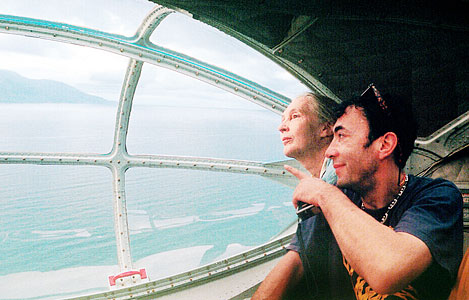 "The
true adventures," says Hubert von Goisern, are not in the head. "They
begin there. But they must manifest themselves. You must live them
and carry them out into the world. Otherwise they remain theories."
"The
true adventures," says Hubert von Goisern, are not in the head. "They
begin there. But they must manifest themselves. You must live them
and carry them out into the world. Otherwise they remain theories."
The unconventional megastar of the native rock scene has taken himself at his word. Three years ago he - to the sorrow of his fans and the horror of his record company - announced his departure from the Hiatamadl success line. He went out into the world: to Asia and to Africa. And now with a turn he is here again. On 29th June his new CDs Inexil and Gombe come onto the market.
The albums have become musical travel reports. They are are (almost) completely free from the familiar Goisern sound and instead open the window to fascinating foreign (yet soon familiar) dimension of sound. Both CDs were shaped by: Goisern's meetings with great contemporaries: the primate research scientist Jane Goodall and the Dalai Lama.
Gombe, the Africa CD: "I visited Jane Goodall in Tanzania," says Hubert von Goisern. "There I had a vision of an album, which carries you away into another world. I worked with a lot with subtle sounds. One cut consists only of natural sounds, where I make music with chimpanzee cries and bird song, with the sounds of wind and water."
Inexil, the Tibet album: "The Tibetan music fascinates me. My idea was, as with my folk music projects, to take it out of pure tradition and to place it in a time reference. In an audience with the Dalai Lama I spoke to him about it and he practically gave his blessing for the album. That was important because afterwards the tradition guardians in their surrounding did not dare to oppose any more!"
For the recordings, he fetched Tibetan musicians to the studio in Salzburg - where they suddenly rediscovered their sounds in a surrounding between reggae and techno. Goisern: "The work was difficult because the Tibetans are so polite. They say yes to everything. After two weeks I flipped out and said that it couldn't possibly be that you like everything I am suggesting. They were really antagonised."
After the method of trial and error, it carried on to the objective. Hubert von Goisern is pleased with the finished product. "What I hope for is to create more awareness for these worlds through the CDs - for their problems, but also for their beauties.
Will one hear the new Goisern on the radio? Goisern: "There is no excuse not to play this music on Ö3 or on private radio. It is pop, it is world music, but not ordinary music. Until now Hubert von Goisern has sold a good million CDs; with the new ones it will be "perhaps 10,000 more". His comment: "That is the advantage of being a star. I can afford to do such projects without asking anyone - because I can simply finance it myself. Even though it was quite expensive."
For the coming year, Hubert von Goisern announced his return to the stage. "The break was long enough. I felt that I feel happiest playing music and that works best when I play in front of people." What will be heard? "Pieces from the current CDs and naturally old titles too. But half of the programme must be written first."
The Africa album. When Goisern sings the Anreisejodler and Abreisejodler, it sounds fairly familiar. In between: full rhythms or velvety sound tapestry from the instruments of African nature. The work, fluctuating with sensuousness, darts stylistically from side to side in a masterly fashion and offers surprises too: for example, when Goisern lets his black sounds vary from a chamber music ensemble.
The Tibet album. The title refers not only to the emigration existence of many Tibetans - their music is also quasi in exile. The definitely daring experiments begin. The meditative Tibetan singing takes it splendidly when it is mixed with reggae, folk rock, a jazz trumpet à la Miles Davis or even techno. Goisern holds himself as a musician - and producer - in the background: a stylistic tour guide between east and west.
Good shall prevail
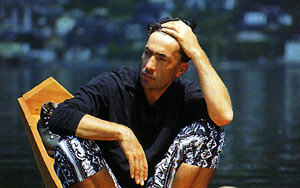 When
the entertainment business looks after the mountain world, experience
recommends scepticism: Beware folksiness! Counterexamples can be counted
on the fingers of one hand. Hubert von Goisern is one such exception.
When
the entertainment business looks after the mountain world, experience
recommends scepticism: Beware folksiness! Counterexamples can be counted
on the fingers of one hand. Hubert von Goisern is one such exception.
The most recent development in the career of this open-minded thinker and straight-forward acting musician and mountain climber makes you curious about this enigmatic person, who confesses to his homeland in his stage name.
Within a few years, hits like Heast as nit and Koa Hiatamadl made the Austrian musician Hubert von Goisern famous and financially independent. Instead of continuing this success with new compositions in the same genre, Hubert von Goisern, born in 1952, separated from the Alpinkatzen in 1995, travelled to Tibet and Africa, and produced two new CDs (Tibet/Inexil, Afrika/Gombe), which are so entirely different musically from his creations until now that you can barely stop yourself asking after the "real Hubert".
"At the age of 22, I switched the points, stopped my training as a chemistry laboratory assistant, left the narrow valley of my homeland and went to Africa. There was no other way to radically loosen yourself from this omnipresent corset of normality and expectations."
Seven years later - in the meantime he had also lived in Canada and the Philippines - Hubert returned to Bad Goisern and henceforth dedicated himself to music.
Now we sit opposite one another in the sizzling heat in the garden of his Munich manager Hage Hein, in the background a bustle without hectic rush; the ZDF confirm the arrangement of a TV appearance, Hubert turns down an ice cream ("it's difficult to talk when eating"), it is a load off the interviewer's mind, because all the questions, which do not directly promote sales of his new work, will be willingly answered. About his alpine sport interests too.
"I climbed mountains as a child, later climbed in the Dachstein and Gosaukamm and also did it after long breaks. For me alpinism has something to do with my inner nature.
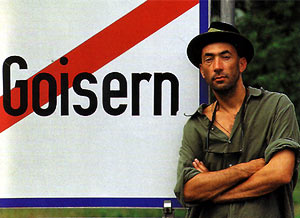 I
don't look for danger, the upper limit. I look for the solitude and
the abandonment. I most like to go up a snowy mountain in winter and
spend the night in a bivouac in the open air. You feel how the cold
slowly creeps into your sleeping bag and feel at the mercy of the weather
and nature. The memory of the warm room returns as a gift not taken
for granted, of nature as it really is with all its variations and
cycles. Therefore I never have a mobile with me in the mountains, I
also refuse to let my companion to have one with them. The umbilical
cord is in the head, you think differently about your boundaries when
you do without the mobile. That is my personal attitude, each person
can think differently."
I
don't look for danger, the upper limit. I look for the solitude and
the abandonment. I most like to go up a snowy mountain in winter and
spend the night in a bivouac in the open air. You feel how the cold
slowly creeps into your sleeping bag and feel at the mercy of the weather
and nature. The memory of the warm room returns as a gift not taken
for granted, of nature as it really is with all its variations and
cycles. Therefore I never have a mobile with me in the mountains, I
also refuse to let my companion to have one with them. The umbilical
cord is in the head, you think differently about your boundaries when
you do without the mobile. That is my personal attitude, each person
can think differently."
But Hubert is is no dogmatist. For example, he also considers the use of drill hooks, used with a good eye for distance, quite legitimate for alpine climbing routes. "I admire the solo climbers and tried it myself once, on the normal path of the Bischofsmütze. A respectable bit above the approach,I fell onto an enormous old snow heap. Otherwise I exercised more alpine reserve and left it at the fifth grade, always in the company of a very good mountain climber anyway."
More and more in the course of the conversation, a picture forms of a personality who avoids rules and principles, but does not act in an undisciplined manner, does not act aimlessly, but lets coincidence have a chance. "The two new CDs were not planned, they were accompanying releases for my journeys, which virtually had their way despite my good sense. I visited Tibet, saw the Kailash, in order to get to know these defenceless spiritual people; I went to Africa, in order to visit the behavioural scientist Jane Goodall in Tanzania and to record a documentary about her work with the endangered chimpanzees.
It is often the case that chance gives me an idea, which is much too costly, too utopian and with time becomes practically tiresome. I presented the musical Africa project to Hage Hein in order to get rid of it from my conscience and have my peace from it. Then I come back from a journey and find out that it is granted and financed. So it can go ahead."
In the course of many years, Hubert has created an identity, constructed a spiritual sounding board, in front of which he test his action and the reality. Among his spiritual teachers are the historian Egon Friedell, the mystic Meister Eckehart, the philosopher Plato, Robert Pirsig, Paul Feyerabend, Peter Sloterdijk and above all the largely unknown Freiburger Wolfgang Struve. "The formulations are the pure spiritual substance, no letter, no comma too many, the thinking is fully purified and gets to the heart of it, the centre always noticeable."
Hubert's inner stability and his self-confidence allows him to deal seriously with criticism. "But when something comes up, I don't run about and ask friends their opinion. I must first of all believe in myself. I deliver nothing that I am not one hundred percent convinced by, and I keep dates when I have promised them. Spontaneity, chance yes, nonsense and doing things off the top of your head, no."
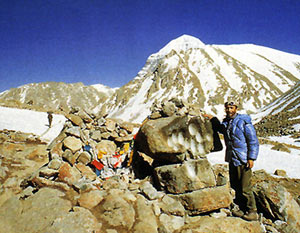 Hubert
certainly does not want to follow the trendy ethno-pop with his new
works. Except for one very catchy piece on the Gombe CD,
the music is much too complex, too tiring. "It is a levelling down,
which leads to indifference towards more ethnic variety. You take a
couple of typical instruments and elements and put your disco rhythm
over it. I see a big chance for us all in the musical meeting, it is
a form of exchange to which I can contribute something, because I can
play a few instruments and sing. My biggest wish for the future is
to appear abroad outside Europe with my music."
Hubert
certainly does not want to follow the trendy ethno-pop with his new
works. Except for one very catchy piece on the Gombe CD,
the music is much too complex, too tiring. "It is a levelling down,
which leads to indifference towards more ethnic variety. You take a
couple of typical instruments and elements and put your disco rhythm
over it. I see a big chance for us all in the musical meeting, it is
a form of exchange to which I can contribute something, because I can
play a few instruments and sing. My biggest wish for the future is
to appear abroad outside Europe with my music."
Likewise, Hubert is a musical autodidact. "I play accordion, piano, guitar, wind instruments and flutes, trumpet, bass, drums and the usual odds and ends like Jew's harp. I approach these instruments from my voice, the discovery of which was the most exciting musical experience for me. Today first of all I sing the various instruments of my compositions and write down the whole composition at the end.
I also learned composing out of laziness because it was too arduous to learn pieces. Behind it, on the other hand, is the obsession with being the best at everything. At the simplest, this works if you have control of a style as the only one. In my homeland there are least twenty who play the accordion better than me, but none of them can play it like me, so in this area I am the best. Similarly, with yodelling I have managed a singing technique which is only practised in the major triad in the first, fourth and fifth degree. With Juchitzer and the live version of Heast as nit, you can hear what I have made of it."
Tibet and Africa, stops on a linear development, to which also belongs a protest against the transit madness in front the Tauern tunnel, in which Hubert took part as well as political debate about the FPÖ populist Jörg Haider. "When I protest against the standardisation mania from Brussels and call to civil disobedience, because a farmer should furthermore decide himself when he cultivates his meadow and mows the field, that does not mean that I am on the side of the EU-opponent Haider. In Goisern he probably already has more than 30% of the votes, accordingly I am popular on account of my political attitude. I am totally decided for a united Europe and believe that the population will understand one another one day and will treat each other peaceably. Fundamentalism is only a last revolt.
I think we have the job to shape the world so that it is it is at its best for us all and must not do what makes it nastier or more cruel. I am convinced that this is the basic need and the heart of human behaviour and that is why in the end good will prevail." And there is not a little bit from one of Hubert's lyrics or music, that puts this opinion in doubt ...
In roots lies strength
There is a life after the Alpinkatzen: the artist Hubert von Goisern
With the Alpinkatzen band, Hubert von Goisern became the celebrated rock star of new folk music. Then he considered it finished, surprised fans and musicians, simply disbanded the successful group. Now the Austrian open-minded thinker returns with new ideas and interesting projects.
The Hallstatt lake is turbulent, which is rare. It has rained the whole day, but now the wind is beating in powerful gusts across the water. Somewhere there outside Hubert von Goisern is standing on a rickety boat which is steered by Peter Seetaler, the best rower in Hallstatt. He is already feeling queasy in the stormy showers, but the fright belongs to adventure, and the man from nearby Goisern searches for that time and time again.
Perhaps he thinks briefly about the horoscope which he laughingly read aloud at lunch in the circle of his musician friends and technicians. "Scorpio: you are swimming against the current again. Your problem. You do not have a lot of help to expect." At least not from above. The planned show - Hubert should be in the middle of the lake, lit from behind with spotlights and also be rowed yodelling in the direction of the stage - falls through because of the storm. But Seetaler brings the musician safely to land. Here the many-voiced battle cry "Hubert, Hubert" is already expecting him. At Hallmania, a multimedia spectacle which was produced on the occasion of Hallstatt being admitted to the World Culture Legacy, he will be wildly cheered by 5000 enthusiastic listeners.
The first stage of a new beginning is completed
A baptism of fire between a provincial laser show and pyrotechnic aha-moments: Hubert's first public appearance after three and a half years. He will play four pieces with his new band, and his guest star, singer Passang Lhamo from the Tibetan Institute of Performing Arts (TIPA) almost takes the audience's breath away with her throat singing, similar to yodelling.
"You're dopey, you're silly," calls one person happily. Hubert there on stage thinks the same thing. No call is made for the Alpinkatzen or old songs. The musicians are in each others arms after their short appearance. The first stage of a new beginning is completed.
The man, whose trademark is wide open climbing boots with no laces, is here again. Welcome back in to the music circus. But 45 year old Hubert Sullivan-Achleitner, who comes from Goisern and makes it known in his popular stage name, will not be the old man any more. Even if he wants to play old songs live again in the coming year. The film work, the meetings and the journeys of the last three years have shaped him. Africa. Austria. Africa. India. Tibet. Jane Goodall, the famous chimpanzee research scientist has become a friend. The Dalai Lama has shown him new ways in a personal conversation in Dharamsala, north India.
First the courage to jump into ice cold water has made all these meetings possible. The decision to abruptly end the success story of his band the Alpinkatzen on the 1st November 1994. Still before the zenith, the appearances at open airs, the great shower of money. Thousands had already celebrated Hubert and his band. In Vienna there were pieces like the Juchitzer or Kren und Speck just as in New York or Paris. Well-made folk music seething with rock, world music of a different style immortalised on four albums, of which more than one million copies were sold. An export hit Made In Austria. Over. Finished. For ever. Yet Hubert von Goisern had had to struggle for his music for years, never gave up although at first, all the record companies in turn said, "No, thank you." At the latest after the hit Hiatamadl, the band was a winner.
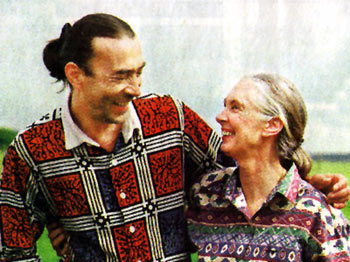 But
the Upper Austrian had simply had enough of the yodelling courtship
on stage, the musician's life. "99.9% of what I wanted to do had
been achieved. More was not possible. If I had led the Alpinkatzen further,
I would have denied myself." He also unconditionally wanted more
time for his two children again. "Due to the long tours there
was a strong estrangement to be felt from my partner, my children and
my friends. Apart from that I had the need to make room again for chance
and new meetings." He never had the feeling that he had made the
wrong decision. Naturally he had also felt a loss, missed the tours
and the jubilations. "It would be lying if I were to say that
it made no difference to me at all. It is a type of addiction to stand
on the stage. Learning to handle my new freedom was also a very painful
process." Not much time remained to the artist to lose himself
in his thoughts, he who also paints pictures and designed an ethnic
collection together with a fashion designer, because there was also
still work as a film composer. He immediately wrote the music for several
films, among others, Josef Vilsmaier's Schlafes
Bruder. The director had had him in mind for the main role,
because he had seen the actor Hubert in the ZDF film Hölleisengretl,
as a convincing farm worker Matthias, but he had to decline on grounds
of time. It was still necessary to mix and market the live CD Wia
die Zeit Vergeht, the legacy of the Alpinkatzen.
But
the Upper Austrian had simply had enough of the yodelling courtship
on stage, the musician's life. "99.9% of what I wanted to do had
been achieved. More was not possible. If I had led the Alpinkatzen further,
I would have denied myself." He also unconditionally wanted more
time for his two children again. "Due to the long tours there
was a strong estrangement to be felt from my partner, my children and
my friends. Apart from that I had the need to make room again for chance
and new meetings." He never had the feeling that he had made the
wrong decision. Naturally he had also felt a loss, missed the tours
and the jubilations. "It would be lying if I were to say that
it made no difference to me at all. It is a type of addiction to stand
on the stage. Learning to handle my new freedom was also a very painful
process." Not much time remained to the artist to lose himself
in his thoughts, he who also paints pictures and designed an ethnic
collection together with a fashion designer, because there was also
still work as a film composer. He immediately wrote the music for several
films, among others, Josef Vilsmaier's Schlafes
Bruder. The director had had him in mind for the main role,
because he had seen the actor Hubert in the ZDF film Hölleisengretl,
as a convincing farm worker Matthias, but he had to decline on grounds
of time. It was still necessary to mix and market the live CD Wia
die Zeit Vergeht, the legacy of the Alpinkatzen.
And then suddenly Jane Goodall, the famous primate research scientist and children's book author, stood before his door in the thickly snow-covered Goisern. An old school colleague introduced him to the woman, whom Hubert had always admired. "Already our first meeting had the quality of a reunion rather than a first acquaintance, and Jane immediately invited me to Africa." A year later she stood there again at the same time and confirmed her invitation.
"I went down in order to meet her, without having a project in the back of my head. I wanted to experience Africa, see the continent through the eyes of this woman. I could listen to her wonderful and fantastical stories and then the things took their course."
Fascinated by everything that was to be experienced down there, the idea grew for a music and the film Von Goisern nach Gombe. An unusual, very intimate film, which showed a different Hubert von Goisern from the one who let off steam on the accordion with the Alpinkatzen. "I appear in the film as I am, I would not like to hold anything back. I was given the gift to open up to others. I can shake off the worry that I possibly disgrace myself. If it seems somewhat kitsch or even pathetic, it does not matter to me."
Shaped by the mysticism of the mountains and valleys
Naturally Jane Goodall has also influenced him on his way to finding himself. Anyway: he feels a great affinity between Jane and the Dalai Lama. "They are both people who go their own way without displaying their power, which they have on account of their reputation. They do it in very soft means and ways. What they want happens without them having to thump the table." That is also an aim with him: to go his way with such self-confidence, to be able to simply let everything happen and to not force anything. To always start with oneself and to not want to start with others.
The Goiserer also gets the necessary self-confidence from his roots, the folk music of his homeland, the cultural roots which he has always felt under his feet. "I am shaped by the landscape in which I have grown up and in which this music has arisen. Through this way of singing, the yodelling and the juchitzer, which can only arise in a landscape like this, in which one wants to frequently cry out. Here in the mountains and valleys is an ecstasy, a mysticism can be felt."
He feels exactly this mysticism in Tibet, a country which as always interested him. Not only on account of the mountains of the Himalayas, but especially because of the valleys which are difficult to reach: "They are the real blank areas on the map." When the question came from the Tseten Peldon, an exiled Tibetan woman living in Austria, whether he could help to get a tour of the TIPA ensemble off the ground, he did not hesitate, "because when does one have a chance to meet such artists in Austria." The music from the ensemble, grounded by the Dalai Lama in 1959, which looks after the Tibetan opera, immediately gripped him. Apart from that, during the concert tour, he heard so many terrible stories from the musicians about the Chinese dictator in Tibet, that he wanted to see with his own eyes what was happening there. "I thought that it simply could not be as they described it." In spring 1996 he set off to Dharamsala and Lhasa with Tseten. With the first meeting with the Dalai Lama, his noticeable aura impressed him. or an hour he presented his musical project to him, to produce contemporary music together with Tibetan musicians. "He gave me the blessing, was very open and said: "Everything is fine. Do it, if you have this idea. Perhaps it will help that the West learns that there is a Tibetan culture." A radical experience."I understand that a culture is intended to be eradicated there and we can simply cannot shut our eyes to it."
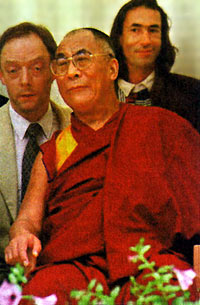 Hubert
von Goisern was horrified by the political situation of the brutal
oppression of a whole nation which he experience in Tibet. Perhaps
the music, which he worked out for his new record InExil with
musicians from the TIPA, therefore so plainly lets the pain be felt,
the deep spirituality, but also the happiness of the people. Tibet
will come to life. You go on a walk with Hubert von Goisern around
the Holy Mountain Laikash, which takes your breath away, not just because
of the thin air, but also because of its views. The folk musician has
become an ambassador without being a Buddhist or a zealot.
Hubert
von Goisern was horrified by the political situation of the brutal
oppression of a whole nation which he experience in Tibet. Perhaps
the music, which he worked out for his new record InExil with
musicians from the TIPA, therefore so plainly lets the pain be felt,
the deep spirituality, but also the happiness of the people. Tibet
will come to life. You go on a walk with Hubert von Goisern around
the Holy Mountain Laikash, which takes your breath away, not just because
of the thin air, but also because of its views. The folk musician has
become an ambassador without being a Buddhist or a zealot.
When he gets a show off the ground in the pump room of the spa town of Bad Ischl, to the opening of which the Dalai Lama comes, then it is not the point for the musician to place special emphasis on the pictures taken of him. He remains in the second row. It is about the right thing.
When after the Dalai Lama's visit he sits in Café Zauner with the Ischl mayor, the country representative and the bishops of both denominations at one table, then you feel how has worked on himself, constantly works on himself. He does not recognise reservations, he does not want to, even though he would rather be standing with the demonstrators at the Brenner blockade.
Here, at the café table, he brings his celebrity to bear, thinking of the people in the Himalayas, for whom he still wants to do something, and of himself. Who knows when one will need grant or sponsor money for ambitious projects, and he has many of those in mind. Sometimes it comes gushing out of him. He is thinking of his tour in the coming spring, in which he wants to play pieces from his Africa and Tibet CDs and old things. Yes, he is itching to do it again and he dreams of going out further than Europe with music projects in the future because he has the feeling "that we have a lot to do with musical ethnicity, which is just as interesting for the people in India, Africa or Australia as their music is for us."
A modern homeland film is his greatest dream
And then there is still the modern homeland film which he has always to shoot. He begins to dream, to picture his concrete plans. With the certain knowledge that his dreams will mostly be realised. Hubert von Goisern was never really away and is now here again. Heast as net?
